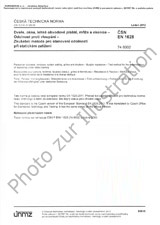Wir benötigen Ihre Einwilligung zur Verwendung der einzelnen Daten, damit Sie unter anderem Informationen zu Ihren Interessen einsehen können. Klicken Sie auf "OK", um Ihre Zustimmung zu erteilen.
ČSN ETSI EN 303978-V2.1.2 (876053)
Satellite Earth Stations and Systems (SES); Harmonised Standard for Earth Stations on Mobile Platforms (ESOMP) transmitting towards satellites in geostationary orbit, operating in the 27,5 GHz to 30,0 GHz frequency bands covering the essential requirements of article 3.2 of the Directive 2014/53/EU
Name übersetzen
NORM herausgegeben am 1.5.2017
Informationen über die Norm:
Bezeichnung normen: ČSN ETSI EN 303978-V2.1.2
Zeichen: 876053
Katalog-Nummer: 501561
Ausgabedatum normen: 1.5.2017
SKU: NS-681937
Zahl der Seiten: 80
Gewicht ca.: 240 g (0.53 Pfund)
Land: Tschechische technische Norm
Kategorie: Technische Normen ČSN
Kategorie - ähnliche Normen:
Radio relay and fixed satellite communications systemsSatellite
Die Annotation des Normtextes ČSN ETSI EN 303978-V2.1.2 (876053):
V2.1.2
The present document applies to Earth Stations on Mobile Platforms (ESOMP), which have the following characteristics.
- The ESOMP is designed for both mobile and stationary operation.
- The ESOMP operates on various mobile platforms such as trains, maritime vessels, aircraft and other vehicles and, therefore, may be subject to occasional disturbances and interruptions in the satellite link.
- The ESOMP is operating as part of a satellite network (e.g. star, mesh or point to point) used for the distribution and/or exchange of information.
- The ESOMP is comprised of all the equipment, electrical and mechanical, from the antenna itself to the interface with other communications equipment on a mobile platform (usually referred to as the terrestrial interface).
- The ESOMP transmits within the frequency range from 27,50 GHz to 30,00 GHz, which is a band allocated to the Fixed Satellite Services (FSS) (Earth to space) among other services. However, operation of the ESOMP is intended to be restricted to the frequency range 29,50 GHz to 30,00 GHz in and near those countries that have allocated Fixed Service (FS) to the other frequency ranges. Local regulation may permit operation in these frequency ranges.
- The ESOMP receives in one or more frequencies within the range from 17,30 GHz to 20,20 GHz (FSS).
- The ESOMP uses linear or circular polarization.
- The ESOMP operates through a geostationary satellite (or a cluster of co-located geostationary satellites) that is at least 2° away from any other geostationary satellite operating in the same frequencies and over the same coverage area.
NOTE 1: ESOMPs may operate with satellites that are more closely spaced than 2° with additional operational constraints that are beyond the scope of the present document.
- The ESOMP is designed for unattended operation.
- The ESOMP is controlled and monitored by a Network Control Facility (NCF). This function may be performed centrally (e.g. for a network of ESOMPs with a central hub) or it could be performed within the ESOMP for autonomous control. The NCF is outside the scope of the present document.
The present document applies to the ESOMP with its ancillary equipment and its various telecommunication ports, and when operated within the boundary limits of the operational environmental profile as declared by the applicant and when installed as required by the applicant´s declaration or in the user documentation.
The present document is intended to cover the provisions of Directive 2014/53/EU [i.11] (RE Directive) article 3.2, which states that ". radio equipment shall be so constructed that it both effectively uses and supports the efficient use of radio spectrum in order to avoid harmful interference".
NOTE 2: Operational requirements are defined by national administrations and by relevant ECC Decisions.
In addition to the present document, other ENs that specify technical requirements in respect of essential requirements under other parts of article 3 of the Directive 2014/53/EU [i.11] may apply to equipment within the scope of the present document.
NOTE 3: A list of such ENs is included on the web site
Normansicht ČSN ETSI EN 303978-V2.1.2 (876053)
Empfehlungen:
Aktualisierung der technischen Normen
Wollen Sie sich sicher sein, dass Sie nur die gültigen technischen Normen verwenden?
Wir bieten Ihnen eine Lösung, die Ihnen eine Monatsübersicht über die Aktualität der von Ihnen angewandten Normen sicher stellt.
Brauchen Sie mehr Informationen? Sehen Sie sich diese Seite an.




 Cookies
Cookies
